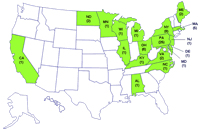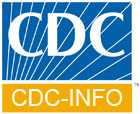Skip directly to the search box, site navigation, or content.
NOTICE: The information on this page is no longer being updated and may have changed. The information is accurate only as of the last page update.
Salmonella Schwarzengrund Outbreak Investigation, August 2007
States with Outbreak-Associated Cases of Salmonella Schwarzengrund, January 1, 2006 - September 4, 2007 (62 cases)

Select map for larger image
States with Outbreak-Associated Cases of Salmonella
Information updated as of September 4, 2007 (FINAL Update)
Click Here for Advice to Consumers
CDC is collaborating with public health officials in Pennsylvania and other state health departments and the US Food and Drug Administration to investigate a multi-state outbreak of Salmonella serotype Schwarzengrund infections in humans. These human illnesses have been linked with dry pet food produced by Mars Petcare US at a single manufacturing facility in Pennsylvania. People who think they might have become ill after contact with dry pet food or with an animal that has eaten dry pet food should consult their health-care providers.
As of September 4, 2007, 62 persons infected with the same strain of Salmonella Schwarzengrund have been reported to CDC from 18 states: Pennsylvania (26 cases), New York (8 cases), Ohio (6 cases), Massachusetts (5 cases), Maine (2 cases), North Dakota (2 cases), Virginia (2 cases), Alabama (1 case), California (1 case), Delaware (1 case), Illinois (1 case), Kentucky (1 case), Maryland (1 case), Michigan (1 case), Minnesota (1 case), New Jersey (1 case), North Carolina (1 case), and Wisconsin (1 case). Of the ill persons for whom an age is available, 39% were one year of age or younger. Of ill persons for whom clinical information is available, 32% developed bloody diarrhea and 10 (25%) were hospitalized. No deaths have been reported.
State and local health departments and CDC continue to receive reports of cases, suggesting the outbreak is ongoing.
Illness related to this outbreak has not been reported in pets. However, the outbreak strain of Salmonella Schwarzengrund was isolated from fecal specimens from two dogs that ate dry pet food in the homes of two of the ill persons.
Investigation of the Outbreak
A multi-state case-control study demonstrated an association between illness and purchase of dry pet foods produced by Mars Petcare US. Households with ill persons were significantly more likely than matched households without ill persons to usually purchase a brand of dry pet food made by Mars PetCare US that may have been produced at a single facility in Pennsylvania.
The Pennsylvania Department of Health (PADOH) conducted environmental testing in this pet food production facility. One of the environmental samples collected by PADOH yielded the outbreak strain of Salmonella Schwarzengrund. In tests by the US Food and Drug Administration of unopened bags of finished dog food produced by this facility, two brands yielded the outbreak strain of Salmonella Schwarzengrund. On August 21, 2007, Mars Petcare US announced a voluntary recall of select bags of these two brands: Red Flannel Large Breed Adult Formula dry dog food and Krasdale Gravy dry dog food (http://www.marspetcare.com/safety/index.html). Neither of these brands has been linked to human illness.
Investigations are ongoing to determine why human illness, especially among infants, is associated with dry pet food. Factors under investigation include handling and storage of dry pet food, hand-washing practices, exposure of children to dry pet food, and location in the home where pets are fed.
Transmission and Clinical Features
Salmonella bacteria live in the intestines of many food animals, such as cows and chickens, and commonly contaminate foods of animal origin. People get Salmonella infection by ingesting these germs, usually in contaminated food or water, but also by putting objects or fingers contaminated with these germs into the mouth.
Most people infected with Salmonella develop diarrhea, fever, and abdominal cramps 1272 hours after infection. Infection is usually diagnosed by culture of a stool sample. The illness usually lasts 4 7 days, and most people recover without treatment. Infants, elderly persons, and people with impaired immune systems are more likely than others to develop severe illness. In severe infection, Salmonella spreads from the intestines to the bloodstream and then to other body sites, and death can occur if the person is not treated promptly with antibiotics.
Advice to Consumers
- Wash hands for at least 20 seconds with warm water and soap right after handling dry pet foods and treats.
- Wash hands before preparing food and before eating.
- Keep infants away from pet feeding areas. Do not allow them to touch or eat dog food.
- Follow the Food and Drug Administration's Safe Handling Tips for Pet Foods and Treats
http://www.fda.gov/consumer/updates/petfoodtips080307.html - Multistate Outbreak of Human Salmonella Infections Caused by Contaminated Dry Dog Food --- United States, 2006--2007 MMWR Weekly, May 16, 2008 / 57(19);521-524.
* Links to non-Federal organizations found at this site are provided solely as a service to our users. These links do not constitute an endorsement of these organizations or their programs by CDC or the Federal Government, and none should be inferred. CDC is not responsible for the content of the individual organization Web pages found at these links.
NOTICE: The information on this page is no longer being updated and may have changed. The information is accurate only as of the last page update.
Content Source: National Center for Zoonotic, Vector-Borne, and Enteric Diseases (ZVED)
Quick Links
Contact CDC

